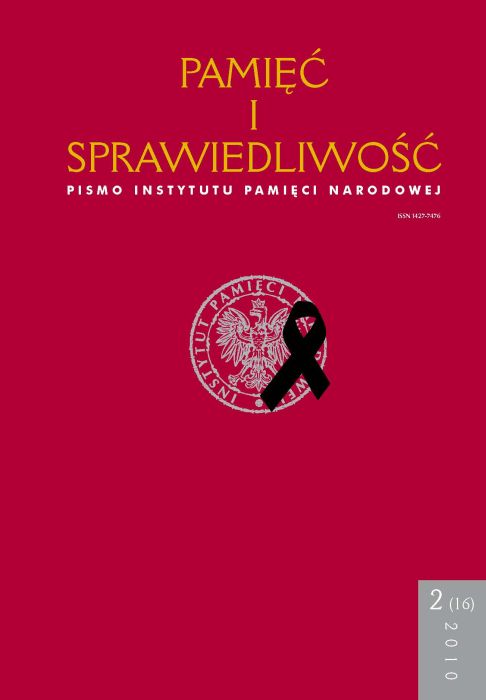„Ostra broń” – agentura celna. Tajni współpracownicy w więzieniach i aresztach śledczych w latach 1944–1956
Pamięć i Sprawiedliwość, Том 16 № 2 (2010), pages: 295-337
Publication date: 2010-12-30
Аннотация
Having had Polish society under systematic observation, the security apparatus was able to carry out its basic operational activity which was maintaining control over people. Among those under surveillance, there were not only ordinary people but also those being imprisoned in detention centres/ custodies and in jails. They were deeply infiltrated by a group of informers, the so-called cell agent network (prisoners-stoolies) recruited among detainees. That special category of the TW (TW – tajny współpracownik, secret collaborator) was considered to be one of
the most important elements of the operational activity. All pieces of information they managed to gather provided investigation functionaries with the solid base for further investigations, interrogations, arrestments, new trials and litigations. Those prison secret collaborators, operating within particular cells, were simultaneously fulfilling two categories of tasks: while they were acting like informants supplying investigation officers with information gained from observation and chats conducted with detainees, they also – by playing psychological game – incited
them to particular behaviours. For instance, they made selected inmates accept all the accusations brought against them by imputing the acts never committed.
What is more, cell agents reported to the SB not only their “friends” from jail but also the prison staff.
Наиболее читаемые статьи этого автора (авторов)
- Jacek Wołoszyn, Dieter Pohl, Bogdan Musiał, [Recenzja] Dieter Pohl, Von der „Judenpolitik” zum Judenmord. Der Distrikt Lublin des Generalgouvernements 1939–1944, Verlag Peter Lang GmbH, Frankfurt am Main–Berlin–Bern–New York-Paris–Wien 1993, ss. 208 i Bogdan Musial, Deutsche Zivilverwaltung und Judenverfolgung im Generalgouvernement. Eine Fallstudie zum Distrikt Lublin 1939–1944, Verlag Harrassowitz, Wiesbaden 1999, ss. 435 , Pamięć i Sprawiedliwość: Том 6 № 2 (2004)
- Jacek Wołoszyn, Konspiracja młodzieżowa na ziemiach polskich w latach 1944–1956 , Pamięć i Sprawiedliwość: Том 17 № 1 (2011)
- Jacek Wołoszyn, Reakcja prasy konspiracyjnej na wydarzenia w Zamojskiem z lat 1942–1943 , Pamięć i Sprawiedliwość: Том 2 № 2 (2002)
- Jacek Wołoszyn, Propagandowa rola procesów członków konspiracyjnych organizacji młodzieżowych w latach 1948–1956 , Pamięć i Sprawiedliwość: Том 43 № 1 (2024)
- Jacek Wołoszyn, Współpraca Związku Młodzieży Polskiej z UB w realizacji planów „ofensywy ideologicznej” w środowiskach młodzieżowych w województwie lubelskim , Pamięć i Sprawiedliwość: Том 12 № 1 (2008)
- Jacek Wołoszyn, Członkowie Związku Młodzieży Polskiej w województwie lubelskim wobec Kościoła katolickiego – przyczynek do dziejów mentalności młodzieży , Pamięć i Sprawiedliwość: Том 7 № 1 (2005)
- Jacek Wołoszyn, Udział organów bezpieczeństwa w akcji rekrutacji na studia w województwie lubelskim w latach 1947–1956 , Pamięć i Sprawiedliwość: Том 11 № 1 (2007)
 Język Polski
Język Polski
 English
English
 Deutsch
Deutsch
 Français (France)
Français (France)
 Italiano
Italiano
 Русский
Русский


 PDF (Język Polski)
PDF (Język Polski)
